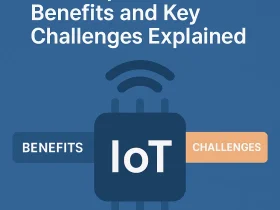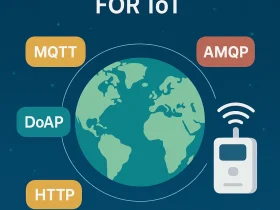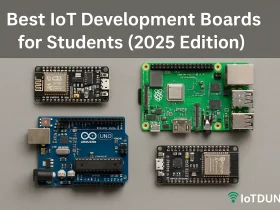MQTT vs CoAP: Detailed Comparison
As the Internet of Things (IoT) continues to evolve in 2025, developers are faced with critical decisions around the technologies that enable devices to communicate efficiently, securely, and reliably. Among these decisions, one of the most important is choosing the right communication protocol.
Two of the most prominent application layer protocols for IoT are MQTT (Message Queuing Telemetry Transport) and CoAP (Constrained Application Protocol). Both are designed to support communication between resource-constrained devices and more powerful internet nodes—but they take fundamentally different approaches.
In this detailed guide, we’ll explore the differences between MQTT and CoAP, understand their architectures, compare their strengths and weaknesses, and provide insights on when to use each based on your IoT application requirements.
What is MQTT?
MQTT, short for Message Queuing Telemetry Transport, is a lightweight, publish-subscribe messaging protocol developed by IBM in 1999. It is designed for scenarios where bandwidth, power, and connectivity are limited—making it ideal for M2M (Machine-to-Machine) and IoT applications.
MQTT Highlights:
- Follows publish-subscribe architecture
- Built on top of TCP/IP for reliable transmission
- Supports three levels of QoS (Quality of Service):
- QoS 0: At most once
- QoS 1: At least once
- QoS 2: Exactly once
- Message routing through a central broker
- Offers persistent sessions and last-will messages
Use Case:
A smart city sensor network publishes air quality data every 10 minutes via MQTT to a central broker. This data is then subscribed to by public dashboards and environmental control systems in real-time.
See also: MQTT Protocol in IoT: A Complete Beginner Guide with Examples & Architecture (2025)
What is CoAP?
CoAP, or Constrained Application Protocol, is a newer protocol designed by the IETF specifically for constrained devices and networks. It is built on UDP and follows a RESTful model, making it closer in design to HTTP but much lighter.
CoAP Highlights:
- Based on client-server model, but supports multicast and observe pattern
- Runs over UDP for low overhead and fast communication
- Built-in support for DTLS (Datagram Transport Layer Security)
- Maps easily to HTTP, making it web-friendly
- Minimal packet sizes, perfect for low-bandwidth networks
Use Case:
An agricultural sensor sends soil moisture data via CoAP to a nearby gateway. If moisture drops below a threshold, the gateway triggers irrigation. CoAP’s low overhead ensures the sensor conserves battery life.
See also: What is CoAP Protocol in IoT? 2025 Guide for Beginners and Developers
MQTT vs CoAP: Feature-by-Feature Comparison
| Feature | MQTT | CoAP |
|---|---|---|
| Architecture | Publish/Subscribe | Client/Server (RESTful) |
| Transport Layer | TCP | UDP |
| Message Format | Binary (compact) | Binary (compact) |
| Overhead | Low | Ultra-low |
| Multicast Support | Not supported | Yes |
| Security | TLS/SSL (manual setup) | DTLS (default integration) |
| Message Types | 16 types | 4 types |
| QoS Support | 3 levels | 2 levels (Confirmable, Non-confirmable) |
| Real-time Updates | Excellent | Excellent |
| Session Management | Persistent sessions supported | Stateless (no session tracking) |
| Power Consumption | Low | Extremely Low |
| Resource Discovery | Topic-based | Well-defined URI structure |
| Web Integration | Indirect (via bridge or gateway) | Direct (HTTP-compatible) |

MQTT: Strengths and Weaknesses
Pros of MQTT:
- Mature and well-supported
- Reliable delivery with QoS levels
- Ideal for real-time bi-directional messaging
- Efficient in high-latency and lossy networks
- Excellent support in platforms like AWS IoT, Azure IoT, and Mosquitto
Cons of MQTT:
- No built-in multicast support
- Not RESTful (requires additional components for web integration)
- Manual TLS configuration for security
- Slightly larger message headers compared to CoAP
CoAP: Strengths and Weaknesses
Pros of CoAP:
- Extremely lightweight with minimal message overhead
- Supports multicast communication
- RESTful—easy to integrate with web technologies
- Built-in support for caching and resource discovery
- Native DTLS integration for security
Cons of CoAP:
- Less mature than MQTT
- Operates over UDP—less reliable transport
- No native broker—more complexity in message routing
- Limited Quality of Service support
MQTT vs CoAP: Which One Should You Use?
Use MQTT if:
- You need real-time bi-directional communication
- Your devices require reliable delivery guarantees
- You’re working with cloud-based platforms like AWS, Azure, or IBM Watson
- Your network supports TCP/IP and you want persistent connections
Use CoAP if:
- You want a lightweight, RESTful interface
- You’re building applications for constrained sensor nodes
- You need multicast support
- Your devices are battery-powered and use connectionless communication (UDP)
- Pro Tip: For many real-world applications, MQTT and CoAP can complement each other. For instance, MQTT may be used to send live data, while CoAP handles configuration and resource management.
Summary
In 2025, both MQTT and CoAP remain top contenders for enabling efficient communication in the IoT space. While MQTT offers robustness and reliability, CoAP provides speed and simplicity. The choice between them depends on your application’s requirements in terms of bandwidth, power, security, integration, and communication model.
Related Articles:
Frequently Asked Questions (FAQ)
1. What is the difference between MQTT and CoAP?
Answer:
MQTT is a publish-subscribe messaging protocol that runs over TCP, ensuring reliable message delivery and persistent connections. CoAP, on the other hand, is a lightweight, RESTful protocol that uses UDP, making it more suitable for power-constrained and lossy network environments.
2. Which is more suitable for real-time IoT applications: MQTT or CoAP?
Answer:
MQTT is generally preferred for real-time IoT applications because it supports persistent connections, broker-based message routing, and Quality of Service (QoS) levels to guarantee message delivery—even in unreliable network conditions.
3. Is MQTT or CoAP better for low-power IoT devices?
Answer:
CoAP is more efficient for low-power devices due to its smaller message size, UDP transport layer, and minimal overhead. It is ideal for battery-operated sensors and embedded systems with limited processing capability.
4. Can MQTT and CoAP be used together in the same IoT system?
Answer:
Yes. In many hybrid IoT systems, MQTT is used for real-time data streaming while CoAP handles device configuration and discovery tasks. Combining both protocols helps leverage the strengths of each in different parts of the system.
5. Is CoAP more secure than MQTT?
Answer:
CoAP uses DTLS (Datagram Transport Layer Security) by default, making it secure for UDP communications. MQTT can be secured using TLS/SSL, but it often requires additional setup. Both can achieve strong security when implemented correctly.
Ready to Explore More? Let’s Build Smarter Together!
Subscribe to Our YouTube Channel » for IoT video Tutorials.
Start Learning IoT Basics Now » and What is IoT? – Introduction to IoT for Beginners on IoTDunia.com!
and Check out Top IoT Applications in Real World – Smart Use Cases 2025, IoT career guide 2025, Best Projects on IoT for Beginners
Your Thoughts?
Have you used MQTT or CoAP in your IoT projects? Share your experiences or questions in the comments below!










Leave a Review